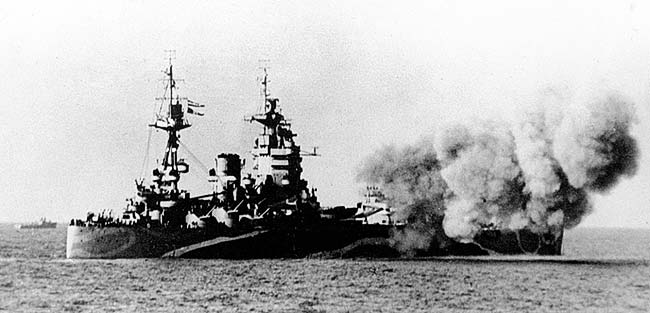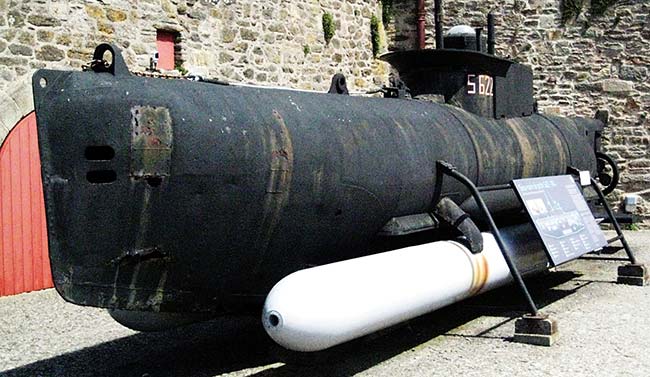D-Day Navies Pt3: Desperate bid to sink a hated battleship
RoIf conventional U-boats could not get right in among the invasion armada then a do-or-die naval commando unit of the Kriegsmarine might and a top target was the 35,000 tons British battleship HMS Rodney.

HMS Rodney bombards enemy units in Normandy, June 1944, delivering what the British Army hailed a ‘Victory Salvo’. Photo: Strathdee Collection.
She was often to be found at anchor off the beaches during June and July 1944. German panzer divisions ashore in Normandy especially hated Rodney, for her massive 16-inch guns had hammered them on several occasions. The men of the Kleinkampfmittelverband, or K-Verband, a special operations unit, were given the task of sinking her.
The German V3 human torpedo was the main weapon deployed by the K-Verband. It actually consisted of two torpedoes – one that its pilot rode, with another slung beneath, which he fired when lined up with a target.

A V3 human torpedo, an art work created especially for ‘HMS Rodney’. Image: Dennis Andrews.
In the early hours of July 6, Rodney was informed human torpedoes and midget submarines were trying to infiltrate Allied anchorages off the beachhead. The warning prompted HMS Rodney to raise steam with all haste, the battleship’s Midshipman Tony Robinson describing ‘panic stations’ though there had already been several false alarms. ‘Someone saw bubbles appearing from the ship’s side,’ he related in his midshipman’s journal.
‘Suspicious of a limpet mine being placed on the hull, the alarm was sounded and a small charge dropped over the side. Investigation proved that someone had left a pump from a bathroom sump running, and after clearing the water it was pumping air out!’
With the prospect of an imminent V3 attack, cutters were sent out to circle Rodney, their crews tasked with dropping small explosive charges to deter the enemy. Motor Launches (MLs) joined in, dropping their own charges. They failed to kill any enemy but threw up plentiful supplies of fish, which were eagerly scooped up by sailors in various ships.

A Seehund midget submarine, this one is today on display at Brest Castle, France. Photo: Iain Ballantyne.
In the meantime, a Polish Navy ML crew captured a V3 and its pilot. Under interrogation he ‘confessed that there were 50 of them operating from… a small town just beyond our eastern flank,’ the Rodney’s Midshipman Roger Morris revealed in his own journal. This prompted Rodney to fire twenty 16-inch shells at factory buildings suspected of hosting the V3s, which were otherwise easily transportable and could be swiftly launched from any beach. The target was obliterated, so ending that particular menace.
However, the V3 attacks continued, with the K-Verband launching dozens at a time – though very few of their pilots survived. Small boats rigged to detonate on impact were another suicidal means of irregular warfare employed by the Germans at this time. Their successes with V3s and other methods of attack included two Allied destroyers sunk, four minesweepers blown up and the Polish cruiser Dragon so badly damaged she had to be scuttled.
The Germans also unleashed midget submarines called Biber and Seehund, which sallied forth from bases on the coast of the Netherlands. The Biber was a one-man craft and operated against Allied shipping in the Channel until the spring of 1945, but sank only a few ships. The Seehund was a two-man craft that, similar to the Biber, carried a pair of torpedoes externally, or mines.
Dozens of Seehunds plagued waters off the east coast of England and achieved very little, except a high casualty rate among the unfortunates who operated them. Hard to handle and slow, like the Bibers they were frequently picked off by aircraft and various Allied naval patrol craft. The propulsion arrangement of a petrol engine could be lethal to a Biber operator. One Biber was discovered stranded on the English coast with its crewman slumped over the controls, killed by carbon monoxide poisoning.
The Biber and Seehund were weapons of desperation and by the middle of August 1944 the U-boat force had also withdrawn from its French bases, sending thirty surviving Type VII submarines to new homes in Norway. As the Allied armies moved beyond even the range of British battleship guns, HMS Rodney and other fire support vessels stood down. The sea battle off Normandy that had started on D-Day June 6, 1944 tailed off dramatically as August drew to a close.
Comments
Comments are closed.